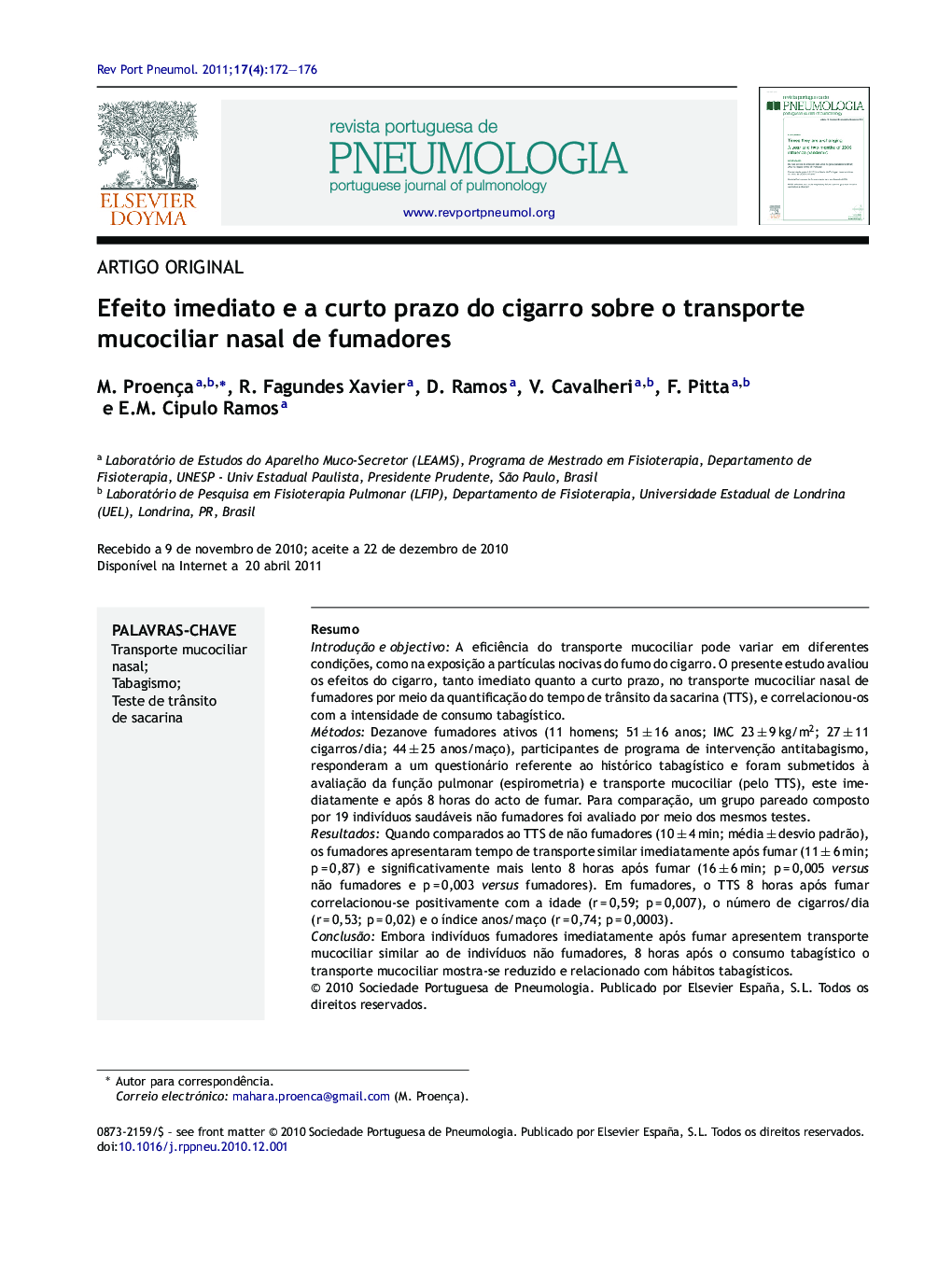| Article ID | Journal | Published Year | Pages | File Type |
|---|---|---|---|---|
| 4214061 | Revista Portuguesa de Pneumologia | 2011 | 5 Pages |
ResumoIntrodução e objectivoA eficiência do transporte mucociliar pode variar em diferentes condições, como na exposição a partículas nocivas do fumo do cigarro. O presente estudo avaliou os efeitos do cigarro, tanto imediato quanto a curto prazo, no transporte mucociliar nasal de fumadores por meio da quantificação do tempo de trânsito da sacarina (TTS), e correlacionou-os com a intensidade de consumo tabagístico.MétodosDezanove fumadores ativos (11 homens; 51 ± 16 anos; IMC 23 ± 9 kg/m2; 27 ± 11 cigarros/dia; 44 ± 25 anos/maço), participantes de programa de intervenção antitabagismo, responderam a um questionário referente ao histórico tabagístico e foram submetidos à avaliação da função pulmonar (espirometria) e transporte mucociliar (pelo TTS), este imediatamente e após 8 horas do acto de fumar. Para comparação, um grupo pareado composto por 19 indivíduos saudáveis não fumadores foi avaliado por meio dos mesmos testes.ResultadosQuando comparados ao TTS de não fumadores (10 ± 4 min; média ± desvio padrão), os fumadores apresentaram tempo de transporte similar imediatamente após fumar (11 ± 6 min; p = 0,87) e significativamente mais lento 8 horas após fumar (16 ± 6 min; p = 0,005 versus não fumadores e p = 0,003 versus fumadores). Em fumadores, o TTS 8 horas após fumar correlacionou-se positivamente com a idade (r = 0,59; p = 0,007), o número de cigarros/dia (r = 0,53; p = 0,02) e o índice anos/maço (r = 0,74; p = 0,0003).ConclusãoEmbora indivíduos fumadores imediatamente após fumar apresentem transporte mucociliar similar ao de indivíduos não fumadores, 8 horas após o consumo tabagístico o transporte mucociliar mostra-se reduzido e relacionado com hábitos tabagísticos.
Background and objectivesThe efficiency of mucociliary transport may vary in different conditions, such as in exposure to harmful particles of the cigarette smoke. The present study evaluated the acute and short term effects of smoking on nasal mucociliary clearance in current smokers by the quantification of the Saccharin Transit Time (STT), and to investigate its correlation with the history of tobacco consumption.MethodsNineteen current smokers (11 men, 51 ± 16 years; BMI 23 ± 9 kg/m2, 27 ± 11 cigarettes per day, 44 ± 25 pack-years), entering a smoking cessation intervention program, responded to a questionnaire concerning smoking history and were submitted to lung function assessment (spirometry) and the STT test. STT was assessed immediately after smoking and 8 hours after smoking. The STT test was also performed in nineteen matched healthy non-smokers’ who served as control group.ResultsWhen compared to STT in non-smokers’ (10 ± 4 min; mean ± standard deviation), smokers presented similar STT immediately after smoking (11 ± 6 min; p = 0.87) and slower STT 8 hours after smoking (16 ± 6 min; p = 0.005 versus non-smokers’ and p = 0.003 versus immediately after smoking). STT 8 hours after smoking correlated positively with age (r = 0.59; p = 0.007), cigarettes per day (r = 0.53; p = 0.02) and pack-years index (r = 0.74; p = 0.0003).ConclusionsIn smokers, although the mucociliary clearance immediately after smoking is similar to non-smokers’, eight hours after smoking it is reduced, and this reduction is closely related to the smoking habits.
